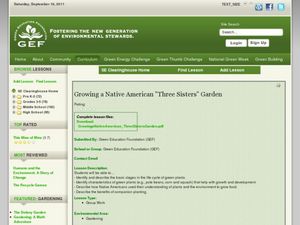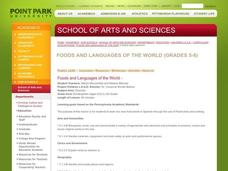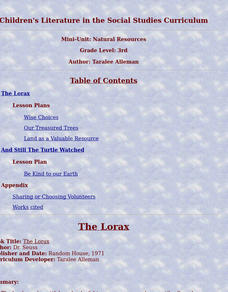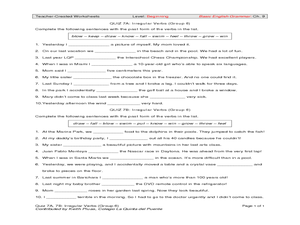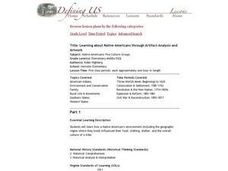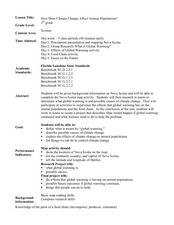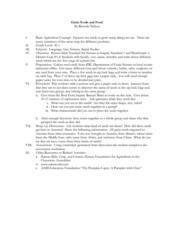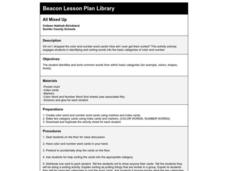Curated OER
The Human Body
Explore the human body through hands-on activities. Young learners will trace their bodies and place cut out body organs in the proper place, print patterns using cut fruit, sing songs about good nutrition, and use their five senses...
Curated OER
Simple Keys and Nutrition
An inventive and engaging lesson on nutrition, food groups, and the food pyramid is here for you. In it, young dieticians learn about the basics of nutrition. They use the book, Frog and Toad are Friends, to help them foster discussion...
Curated OER
Growing a Native American "Three Sisters" Garden
Students explore plant life by creating their own gardens in class. In this food growing lesson plan, students discuss the types of gardening methods Native Americans used in order to keep healthy. Students plant corn seeds in their...
Curated OER
Habitat Basics
First graders get out and explore two different habitats to examine how each one meets the needs of the plants and animals that dwell there. They discuss what they've learned about animal habitats as they explore the outdoor environment....
Curated OER
Nutrition Unit
First graders complete activities for the six basic food groups. In this food groups lesson plan, 1st graders view examples of food samples from the various groups and sample the foods. Students discuss the food pyramid and draw a fruit...
Curated OER
Test Your Speaking & Listening Skills: Lucky Dip 2
Sometimes your English language learners don't need structured speaking practice to build oral fluency. This fun trivia worksheet provides them several opportunities to talk. In groups, they must list three countries in Asia, three...
Curated OER
Who Eats Who?
Students recognize that some animals eat plants, some eat meat and some both. For this who eats who lesson, students chart animals in a food chain. Students research information from reading articles. Students chart...
Curated OER
Foods and Languages of the World
Young scholars review Mexico's location and language and learn to pronouns 10 new Spanish food words. Students listen as the book, Corn is Maize is read, touching and passing around an ear of Indian corn. Young scholars discuss the...
Curated OER
Pyramid Panic Lesson
Students research human health by identifying fatty and sugary foods. In this food choices lesson, students discuss the five food groups and examine the healthiest choices from each group. Students utilize the web to complete a health...
Curated OER
Land as a Valuable Resource
Students investigate why the soil is important to our lives. In this natural resources lesson, students have a farmer as a guest speaker. Students begin to understand how farmers use and protect our natural resource. Students write...
Houghton Mifflin Harcourt
Amazing Animals: Challenge Activities (Theme 4)
For kids who have already mastered the basic concepts in the Houghton Mifflin Harcourt thematic units on amazing animals, here's a packet of enrichment activities sure to provide food for fertile minds.
Curated OER
Good Enough To Eat
Students are introduced to the five food groups. In groups, they place different foods into the correct section of the Food Pyramid. Using different types of technology, they create one page of a class ABC book sharing what they know...
Curated OER
Test Your Speaking & Listening Skills: Lucky Dip 3
Group your English language learners for this fun trivia exercise. There are 20 questions for each group to discuss. They must name different animals that live in water, recall basic vocabulary terms, recall the capital of Russia, etc....
Curated OER
Irregular Verbs
Divided into two 10-question exercises, this instructional activity provides practice with irregular verbs in the simple past tense. Ten present-tense, monosyllabic verbs are given in a word bank; learners write the past tense form in a...
Curated OER
Learning about Native Americans through Artifact Analysis and Artwork
Sixth graders assess how a Native American's environment and the geographic region where they lived influenced their food, clothing, shelter and the overall culture of a tribe. They study the impact of conservation, family, rural life,...
Curated OER
Quiz 8A: Irregular Verbs (Group 6)
In this verbs activity, students complete 20 sentences by filling in the past form of the verbs provided in the word box. The verbs will have irregular spellings.
Arizona-Sonora Desert Museum
Desert People and the Saguaro
The saguaro is the focus of an examination of the importance of this stately cactus to the indigenous people in the Sonoran Desert.
Curated OER
Oh Deer! and English Learner Writing Extensions
Students follow deer through Yellowstone Park and record the number of deer from year to year. In this basic needs of deer lesson, students work in small groups and chart the number of deer each year and give explanations using as...
Curated OER
How Does Climate Change Affect Animal Populations?
Young scholars investigate the effect of climate change on animal population in Nova Scotia. In this environmental science lesson, students complete a Nova Scotia map activity and research the causes of global warming in small groups....
Curated OER
Grain Seeds and Food
Students observe the characteristics of different seed types. They classify, sort, name and write about the seeds.
Curated OER
All Mixed Up
Students identify and sort words into the basic categories of color and number. After a lecture/demo, students utilize a worksheet imbedded in this plan to gain practice sorting number words.
Curated OER
Altruism: Meeting Society's Needs
Students study society's needs and altruism within communities. In this altruism lesson, students identify and categorize the basic needs that human beings have and define altruism. Students complete research on altruistic...
Curated OER
Colored Clouds
Fourth graders, in groups, examine how particles in warm water move faster than particles in cold water.
Curated OER
Creature Creation
Second graders listen to a read aloud of a fictional story about a frog. They compare the characteristics of the main character with a real frog. They work with two partners to create a creature; one student draw the head, one the body,...


